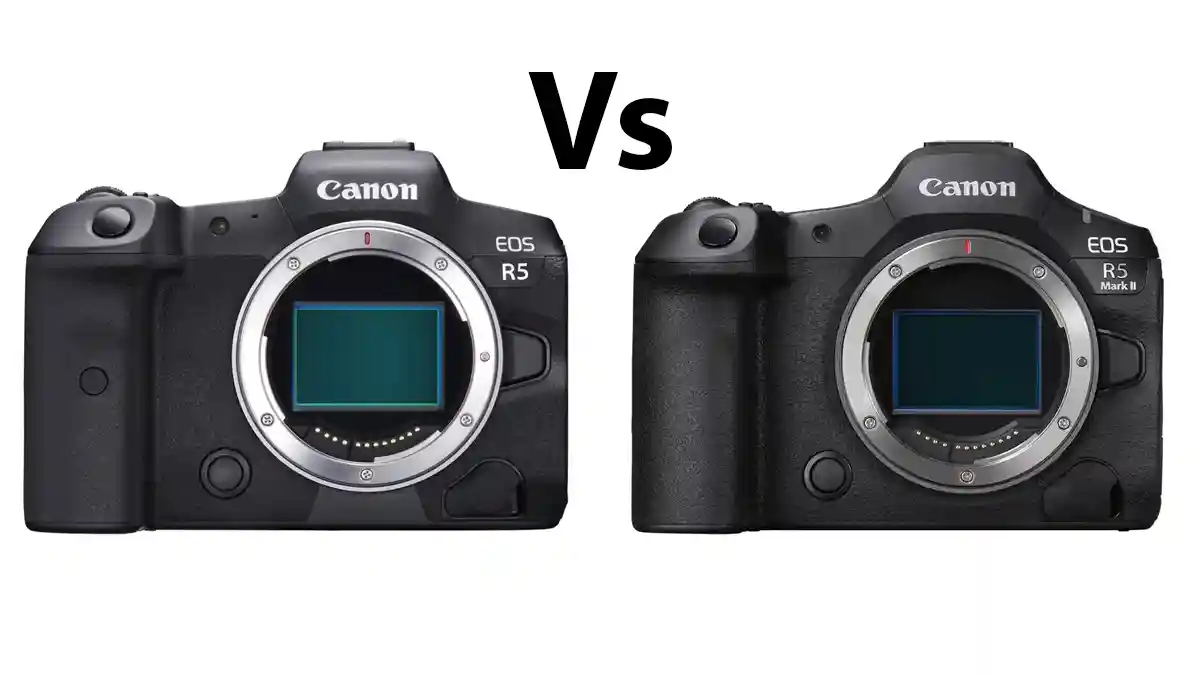Canon has long been a leader in the world of digital photography, consistently pushing the boundaries with each new camera release. The Canon EOS R5 and its successor, the Canon EOS R5 Mark II, are prime examples of this innovation. This comparison delves into the differences and improvements across various aspects, including physical build, sensor and processors, memory card slots, stills shooting rate, autofocus (AF) speed and modes, video capabilities, and price.
Check out the full Canon EOS R5 Mark II announcement coverage here.
Physical Build, Weight, and Size
Canon EOS R5 Physical Build, Weight, and Size: The Canon EOS R5 features a robust magnesium alloy body, which provides a durable and reliable build suitable for professional use. Its design includes comprehensive weather-sealing that offers protection against dust and moisture, making it versatile for a wide range of shooting environments, from studio to fieldwork. The camera’s dimensions are 138 x 97.5 x 88 mm, and it weighs approximately 738 grams, including the battery and memory card. This build quality ensures that the EOS R5 can endure the rigours of professional photography, whether you’re capturing landscapes in harsh weather or shooting in a controlled studio setting. The overall design of the EOS R5 combines functionality with durability, providing photographers with a reliable tool that can handle demanding conditions while delivering high performance.
Canon EOS R5 Mark II Physical Build, Weight, and Size: The Canon EOS R5 Mark II, while maintaining the same magnesium alloy construction, incorporates several enhancements to improve its durability and ergonomics further. The dimensions are slightly adjusted to 139 x 98 x 89 mm, and the weight is increased to around 750 grams. These minor changes reflect a focus on better handling and heat dissipation, which is crucial for extended shooting sessions. The R5 Mark II’s weather-sealing has also been refined to offer even better protection against the elements. These enhancements ensure that the camera remains comfortable to use over long periods, while also being more robust against the rigors of professional use. The slight increase in size and weight is a trade-off for these improvements, making the R5 Mark II a more versatile and reliable tool for professional photographers.
Sensor and Processors
Canon EOS R5 Sensor and Processors: The Canon EOS R5 is equipped with a 45MP full-frame CMOS sensor, which, in combination with the DIGIC X image processor, delivers outstanding image quality. This sensor and processor pairing provides a wide dynamic range, excellent low-light performance, and fast readout speeds essential for high-speed continuous shooting and video recording. The DIGIC X processor is known for its efficiency in handling large amounts of data quickly, ensuring that the camera can maintain high performance even in demanding shooting scenarios. This combination of a high-resolution sensor and a powerful processor makes the EOS R5 capable of producing highly detailed images with accurate color reproduction, making it suitable for a variety of professional photography applications.
Canon EOS R5 Mark II Sensor and Processors: The Canon EOS R5 Mark II marks a significant upgrade with its 61MP back-illuminated CMOS sensor. This new sensor increases resolution and detail, aiming to rival competitors like the Sony A7R V. Paired with the dual processor system comprising the DIGIC X and the new DIGIC Accelerator, the R5 Mark II offers enhanced data processing capabilities. This combination improves noise reduction and supports the higher resolution and faster readout speeds necessary for high-speed shooting and 8K video recording. The DIGIC Accelerator specifically helps in managing the large volumes of data generated by the 61MP sensor, ensuring smooth and efficient performance. This setup not only enhances image quality but also boosts overall camera performance, making the R5 Mark II a superior choice for professionals seeking top-tier imaging capabilities.
Memory Card Slots
Canon EOS R5 Memory Card Slots: The EOS R5 features a dual memory card slot configuration, with one CFexpress Type B slot and one SD UHS-II slot. This setup provides flexibility, allowing photographers to use high-speed CFexpress cards for tasks that require fast data transfer rates, such as 8K video recording, while still maintaining compatibility with the more affordable and widely available SD cards. This combination ensures that photographers can choose the best card for their needs without compromising on performance. The dual card slots also offer redundancy, allowing for simultaneous recording to both cards for backup purposes, which is essential for professional work where data security is paramount.
Canon EOS R5 Mark II Memory Card Slots: In contrast, the EOS R5 Mark II is expected to feature dual CFexpress Type B card slots. This change reflects the increased data demands of the higher resolution sensor and enhanced video capabilities of the R5 Mark II. Dual CFexpress slots provide faster write speeds and greater storage capacity, which are essential for handling large video files and continuous burst shooting. This setup ensures that photographers can maximize the camera’s performance without being limited by slower card speeds. The use of two CFexpress cards also enhances reliability and efficiency in professional workflows, making the R5 Mark II better suited for high-stakes photography and videography.
Stills Shooting Rate
Canon EOS R5 Stills Shooting Rate: The EOS R5 offers impressive continuous shooting capabilities, with up to 20 frames per second (fps) using the electronic shutter and 12 fps with the mechanical shutter. This high-speed performance is supported by the camera’s advanced autofocus system, ensuring that it can track and capture fast-moving subjects accurately. This capability makes the EOS R5 suitable for a wide range of applications, including sports and wildlife photography, where capturing split-second moments is crucial. The combination of high shooting speed and reliable autofocus ensures that photographers can achieve sharp and detailed images, even in challenging shooting conditions.
Canon EOS R5 Mark II Stills Shooting Rate: The EOS R5 Mark II enhances this capability significantly, offering a burst rate of 30 fps using the electronic shutter. This increase provides even greater potential for capturing high-speed action, making it an ideal choice for professional sports and wildlife photographers. The mechanical shutter’s rate remains similar at 12 fps, providing a reliable option for situations where an electronic shutter might not be suitable. The increased speed of the electronic shutter in the R5 Mark II is made possible by the improved sensor and processor combination, ensuring that photographers can capture more frames in quick succession without compromising on image quality. This enhancement positions the R5 Mark II as a top performer in high-speed photography.
Autofocus Speed and Modes
Canon EOS R5 Autofocus Speed and Modes: The original EOS R5 is equipped with Canon’s Dual Pixel CMOS AF II, featuring 1,053 AF points that cover nearly 100% of the frame. This autofocus system offers excellent subject tracking and face/eye detection, ensuring accurate focus in various shooting conditions. The AI-driven features of the AF system enhance its ability to track animals and vehicles, providing reliable performance in dynamic environments. This comprehensive autofocus system ensures that the EOS R5 can handle a wide range of subjects and shooting scenarios, making it a versatile tool for professional photographers.
Canon EOS R5 Mark II Autofocus Speed and Modes: The EOS R5 Mark II builds on this foundation with further enhancements to the Dual Pixel CMOS AF II system. The autofocus is now even faster and more accurate, thanks to AI-driven improvements. These enhancements provide better tracking of animals, vehicles, and human faces and eyes, ensuring high-speed, high-accuracy subject recognition and tracking, even in complex and dynamic shooting environments. The AI improvements make the autofocus system more reliable and efficient, allowing photographers to maintain focus on their subjects seamlessly. This makes the R5 Mark II particularly suitable for action photography and videography, where maintaining accurate focus on moving subjects is critical.
Video Capabilities
Canon EOS R5 Video Capabilities: The EOS R5 is renowned for its video capabilities, offering 8K video recording at up to 30fps, 4K video at up to 120fps, and Full HD at 240fps. It supports 10-bit 4:2:2 internal recording with Canon Log, providing extensive post-processing flexibility. However, the camera faced some criticism for overheating issues during extended 8K recording sessions. Despite this, the EOS R5’s video capabilities make it a powerful tool for professional videographers, offering high-resolution recording and slow-motion options that are essential for creative projects.
Canon EOS R5 Mark II Video Capabilities: The EOS R5 Mark II addresses these concerns with improved heat dissipation, allowing for longer recording times. It supports 8K video recording at 60fps, providing higher resolution and smoother footage for filmmakers. Additionally, it maintains 4K video at 120fps and Full HD at 240fps for slow-motion playback, offering greater flexibility for creative projects. The 12-bit RAW recording feature allows for high-quality video output, retaining more image data for greater flexibility in post-production editing. These advancements make the EOS R5 Mark II a more robust tool for professional videography, ensuring that videographers can achieve the highest quality footage without being limited by heat-related issues.
Price
Canon EOS R5 Price: At its launch, the Canon EOS R5 was priced at approximately $3,899 / £4,199 / AU$6,899. This positioned it as a high-end option for professional photographers and videographers seeking advanced features and performance. The price reflected the camera’s capabilities and its position in the market as a flagship model in Canon’s mirrorless lineup. The EOS R5 offered a compelling combination of high-resolution stills, advanced autofocus, and professional video capabilities, making it a valuable investment for professionals.
Canon EOS R5 Mark II Price: While the exact pricing for the EOS R5 Mark II has not been confirmed, it is expected to be in a similar range to its predecessor, with slight adjustments for inflation and additional features. Estimates suggest a launch



